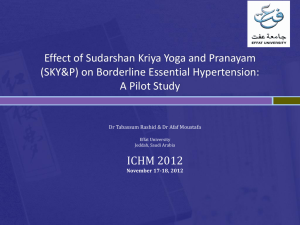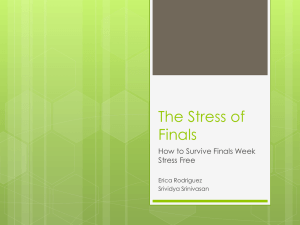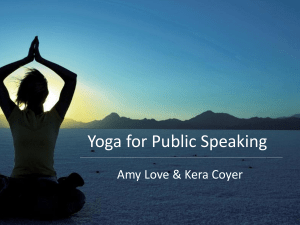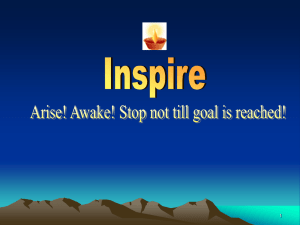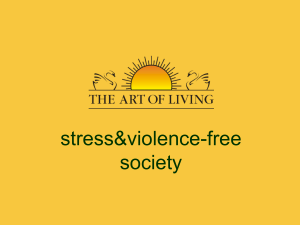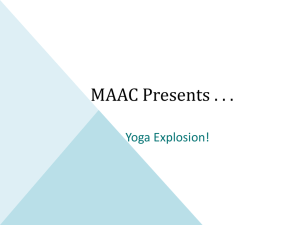Yoga Breathing Neurophysiological Model & Clinical
advertisement
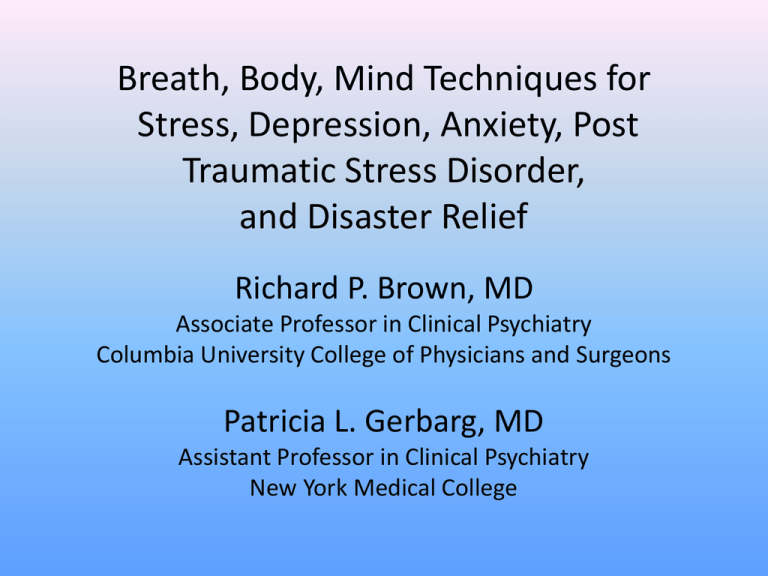
Breath, Body, Mind Techniques for Stress, Depression, Anxiety, Post Traumatic Stress Disorder, and Disaster Relief Richard P. Brown, MD Associate Professor in Clinical Psychiatry Columbia University College of Physicians and Surgeons Patricia L. Gerbarg, MD Assistant Professor in Clinical Psychiatry New York Medical College Presenter Disclosures Richard P. Brown, MD Patricia L. Gerbarg, MD The following personal financial relationships with commercial interests relevant to this presentation existed during the past 12 months: No relationships to disclose. Evolving Roles for Mind-Body Practices in Public Health stress, anxiety, insomnia, depression Prevent/relieve effects of mass disasters Military service related stress and PTSD Stress-related medical illness: eg. cardiovascular, Inflammatory Bowel Disease • Children: stress, trauma, ADHD, emotion regulation • Health care provider and care giver stress • Cost of health care and accessibility of care • • • • Gray’s Motivational Theory Approach Reward Fight/Flight Behavioral Activation System (BAS) Dopamine Freeze Avoidance Behavioral Inhibition System (BIS) Serotonin Norepinephrine Sympathetic Nervous System (Stress Response: Burns Energy) (Beauchaine, T. 2001. Vagal tone, development, and Gray's motivational theory: toward an integrated model of autonomic nervous system functioning in psychopathology Dev Psychopathol 13:183-214.) Autonomic Nervous System Sympathetic System Parasympathetic System Approach (BAS) Avoidance (BIS) Emotional Regulation (Vagal Nerves) Behavior & Emotion Breath and Emotion • Bi-Directional • Specific emotions induce breath patterns • Voluntary changes in breath patterns induce specific emotions (Philippot P, Chapelle G & Blairy S. Respiratory feedback in the generation of emotion. Cognition and Emotion, 2003, 16(5):605-627) Vagus Nerves are Involved in: • Social bonding • Empathy & love • Gut feelings & instincts • Perception & observation Carter, CS. 1998. Neuroendocrine perspectives on social attachment and love. Psychoneuroendocrinology, 23 (8), 779–818; Porges, SW. 2001. The polyvagal theory: phylogenetic substrates of a social nervous system. International Journal of Psychophysiology, 42(2), 123-46. Vagal Nerve Pathways Brown RP, Gerbarg PL. 2009. How to Use Herbs, Nutrients, and Yoga in Mental Health Care. NY; WW Norton. P79. Heart Rate Variability at 5 breaths per minute at 15 breaths per minute at 7.5 breaths per minute at 30 breaths per minute Copyright 2007 S. Elliott. Used with Permission. “The purpose of breathing practices is to induce the tenderness of a new-born babe.” Lao Tzu, Tao Te Ching Clinical Studies: Breath-Centered Programs 1. 2. 3. 4. 5. 6. 7. 8. Generalized Anxiety Disorder Schizophrenia Inflammatory Bowel Disease Southeast Asia Tsunami Survivors Australian Vietnam Veterans 9/11 World Trade Center Attacks Mississippi Healthcare Providers South Sudanese Survivors of War & Slavery Effects of a Yoga-Breath Intervention Alone and in Combination with an Exposure Therapy for PTSD and Depression in Survivors of the 2004 Southeast Asia Tsunami. Acta Psychiatr Scand 2010. 121(4):289-300. Teresa Descilo, Patricia Gerbarg, A Vedamurtachar, D Nagaraja, BN Gangadhar, R Damodaran, B Adelson, L Braslow, S Marcus, Richard P Brown Severely Traumatized Population • Refugees from the most severely damaged coastal villages in India • Living in 5 refugee camps 9 months after the tsunami • In the state of Tamil Nadu, 75% of the deaths occurred in this small district: Nagapattinam Study Design 183 subjects: 3 equal groups, assigned by camps 1. Breath Water Sound (BWS) + 10-minute Sudarshan Kriya: 2 hours/day, 4 consecutive days = total 8 hours 2. B+T: BWS followed 3 days later by TIR (Traumatic Incident Reduction, client-driven exposure therapy) 3-5 sessions 3. CON: 6-week wait-list Control Group Collaboration: National Institute of Mental Health and Neurosciences of India, The Trauma Center of Dade County Florida, The International Association of Human Values Mean Scores PTSD Checklist PCL-17 P < .001 Mean BDI Scores P < .0001 Multi-component Yoga Breath Program for Vietnam Veteran PTSD: Randomized controlled trial. J Carter, PL Gerbarg, RP Brown, et al. • 25 Australian Vietnam Veterans with chronic, treatment resistant PTSD disabled • Clinician Administered PTSD Scale (CAPS) • Mini-Plus, AUDIT, PCLM, CES-D • baseline, pre, 6 week-post, 6-month post J Traumatic Stress Disorders & Treatment. 2013.2(3):1-10. Outcomes Over 6 Months: CAPS Minimizing Rapid or Forceful Breathing Reduces the Following Risks • • • • • • • • Panic Disorder - panic attacks Generalized Anxiety Disorder - anxiety Post Traumatic Stress Disorder – flashbacks Seizure disorder - seizure Acute asthma or dyspnea - exacerbation Uncontrolled hypertension - BP Bipolar disorder – manic episodes Pregnancy Breath-Body-Mind includes the following breathing practices • Coherent Breathing – Rate: 3.5 to 6 breaths per minute – Equal inhalation and exhalation – Like natural breathing: quiet and gentle • Breath Moving: imaginative • Resistance Breathing on exhalation • “Ha” Breath (briefly 2 to 5 minutes) • 4-4-6-2 Counts Breathing (RP Brown & PL Gerbarg (2012). The Healing Power of the Breath. Book + CD. Boston: Shambhala Press.) 1st & 2nd Trials of Breath~Body~Miond for relief of PTSD, Depression, and Anxiety Related to September 11th NYC WTC Attacks. RP Brown, PL Gerbarg, M Vermani, MA Katzman 1st Trial: Breath~Body~Mind Workshop 12 hour workshop taught over 2 days 1. Resistance + Coherence Breathing (5 bpm) + Breath Moving 2. QiGong: Gentle movements with Resistance Breath – QiGong breathing: counts & holds 4–4–6–2 3. Open Focus meditation: improves flexibility of attention (Les Fehmi) – First focus on internal spaces of the body. – Connect internal spaces with space in environment. Increases alpha brain wave synchrony. 4. Group Processes Presented at American Psychiatric Association Annual Meeting May 2013, San Francisco, CA ©2012 RPBrown & PLGerbarg 1st Trial: T-Test Results Pre vs Post Scores df t Significance Anxiety Sensitivity Index 16 5.33 .001 Beck Anxiety Inventory 13 4.02 .001 Beck Depression Inventory 16 7.38 .001 Penn State Worry Questionnaire Sheehan Disability Index Social Life 15 3.18 .006 15 3.44 .004 Bonferroni t-tests significance 0.05/9 = .006 n = 17 subjects ©2012 RPBrown & PLGerbarg 2nd Trial: Breath~Body~Mind Workshop 12 hour workshop taught over 2 days 1.Coherence (5 bpm), Resistance Breath, Breath Moving 2.QiGong: Gentle movements 1. counts 4–4–6–2 3. Open Focus meditation: trains flexibility of attention (Les Fehmi) – First focus on internal spaces of the body. – Connect internal spaces with space in environment. Increases alpha brain wave synchrony. 4. Group Processes (Presented American Psychiatric Association Annual Meeting May 2013, San Francisco, CA) ©2012 RPBrown & PLGerbarg September 11th Experience Total N = 27 participants First Responder Firemen Worked with or affected by 9/11 Emergency Health Care Provider Worker at Ground Zero (post attack) Resident Living near World Trade Center Witnessed Attack Family member of a first responder Escaped from World Trade Center N 6 4 4 2 6 10 8 1 2 Number of Participants Meeting Criteria for a Clinical Disorder Clinical Disorder N Major Depressive Disorder 12 Generalized Anxiety Disorder 14 Post Traumatic Stress Disorder 23 Panic Disorder 16 Agoraphobia 9 Note: Total N = 27 participants 2nd Trial: T-Test Results Pre vs. Post df t Significance Anxiety Sensitivity Index 21 3.93 .001 Beck Depression Inventory 20 4.01 .001 Beck Anxiety Inventory 21 3.09 .005 Penn State Worry Questionnaire Treatment Outcome PTSD Scale 19 1.95 .066 (ns) 18 1.63 .120 (ns) Bonferroni t-tests significance 0.05/5 = .01 Adapting Mind/Body Practices for Mass Disasters • • • • • • • • Few teachers serve large groups Simple techniques, easy to learn and teach Rapid relief Safe for all, regardless of age, trauma, illness Understood and accepted by diverse cultures No equipment, electricity, buildings, or supplies Lower cost Sustainability: train community leaders to teach (RP Brown & PL Gerbarg (2012). The Healing Power of the Breath. Book + CD. Boston: Shambhala Press.) Breath~Body~Mind Training for Stress Relief after Gulf Oil Spill (Mississippi State DMH Grant) Assisted by Mississippi Cares & Serving Those Who Serve Chris Streeter Boston University Medical Center Patricia Gerbarg New York Medical College Richard P Brown Columbia University College of Physicians & Surgeons Breath~Body~Mind Training-the-Trainer for Stress Relief Post Disaster • 153 service providers: social workers (31%), counselors (15%), teachers (10%), psychologists (8%), case workers (5%) • Mississippi counties affected by Gulf Oil Spill • 3-day 18-hr Train-the-Trainer • Exercise Induced Feeling Inventory (EIFI) • Perceived Stress Scale (PSS) (Poster presented at SYTAR (Symposium of yoga Therapy and Research), Stockbridge, MA. Sept. 23-25, 2011. Mean Scores Perceived Stress Scale compared to norms for women and men Pre- and 6 Weeks Post- Training Normed Female 20 18 Normed Male 16 Trainees 14 12 10 8 6 4 2 0 Pre 6 weeks (Gerbarg PL, Streeter CC, Whitfield T, Brown RP. Poster presented at SYTAR, Stockbridge, MA. Sept. 23-25, 201). Exercise Induced Feeling Inventory (EIFI) • post tests at 6 weeks showed statistically significant improvements in mean scores for: • Revitalization: mean (p < 0.001) • Tranquility: mean (p < 0.001) • Physical Exhaustion: (p < 0.04) • Positive Engagement showed trend toward improvement but not of statistical significance (Gerbarg PL, Streeter CC, Whitfield T, Brown RP. Poster presented SYTAR, Stockbridge, MA.Sept.23-25, 2011) 2012 Haiti Earthquake • Gretchen Wallace, founder/director Global Grassroots, supports conscious social change, for vulnerable women at the grassroots level. • Brief (30 minutes) work with 50 women 1 week after the Earthquake: relief of stress symptoms, back pain, worry, insomnia • 1 month later the women continued to practice together and brought friends – 80 women • The Academy for Conscious Change, a 12-18 month incubator offering social venture development skills, leadership training, and grants for disadvantaged women to initiate their own civil society organizations. www.globalgrassroots.org War and Slavery in Sudan It is estimated tens of thousands of South Sudanese captured during the last two decades of war remain in slavery in North Sudan. $100,000 worth of bovine vaccine purchases freedom for one of these slaves. Independence Day Flag S.Sudan July, 2011 photo by G Weibach Sudanese Survivors of War and Slavery Program Evaluation • Short form of Breath~Body~Mind practices • 3 Qigong movements and 20 minutes of Coherent Breathing with the clinic staff 5 days a week for 18 weeks. • VAS Mood Scale and VAS PTSD Scale. • 19 South Sudanese women (Drs. Luka Deng, PL Gerbarg & RP Brown, 2011; Gerbarg, Wallace, Brown. 2011. Mind-body solutions for mass disasters: challenges and field experience. Int. J. Yoga Therapy. No. 21: 23-34.) Program Evaluation Data from Sudan: Response of Refugees to Breath-Body-Mind Practices Change Mean Score/ % Change Mean Score Mean Test Scores Baseline 6 wks 18 wks 0-6 wks VAS 49.3 PTSD VAS 20.8 Mood 17.2 14.5 10.8 7.1 32.1 65% 10.0 48% 0-18 wks 34.8 71% 13.7 66% VAS: Visual Analogue Scale n = 19 women (Gerbarg, Wallace, Brown. Int J Yoga Therapy. 2011. 21:23-34) 600 Liberated Slaves • Walked for 1 week and crossed the border into S. Sudan July 4, 2011 • Dr. Luka Deng and clinic staff evaluated • Relief workers provide grain and utensils • Dr. Richard Brown taught Breathing Practices for 30 minutes • Village chiefs identified and helped return their people to villages of origin 2011 RPBrown & PLGerbarg Traumatic Experiences • Disturbances in neural networks • Leave impressions on the mind: trauma memories (subsymbolically encoded), physical sensations, emotion dysregulation • Difficult to access with verbal therapies • Disruption of bonding, disconnectedness, loss of meaning, emotional numbing (RP Brown, PL Gerbarg. 2012. The Healing Power of the Breath. Book + CD. Boston:Shambhala Press) 2012 RPBrown & PLGerbarg Interoception provides substrate for emotional awareness • Interoception: the perception of ‘feelings’ (eg. gut, viscera, genital, vasomotor, muscular, air hunger, pain, temperature, sensual touch) reflecting internal state of the body • Primary representation in dorsal posterior insula meta-representation anterior insula map & regulate internal states (Craig AD. Interoception: The sense of the physiological condition of the body. Curr Opin Neurobiol, 2003.13(4):500–505; Critchley HD. J Comp Neurol. 2005; Damasio RR. The Feeling of What Happens: Body and Emotion in the Making of Consciousness. NY: Harcourt Brace 1999) Interoceptive afferent pathways project to dorsal posterior insula (interoceptive cortex) (R – SNS; L – PNS) and medial frontal region (anterior cingulate cortex, ACC). (Used with permission. A.D. Bud Craig. Interoception & Emotion, Ch 16 Handbook of Emotions 3rd Ed, Ed. M Lewis, JM HavilandJones, LF Barrett, NY: Guilford press 2008, pg 275) Anatomical Model The subjective awareness of feelings from the body is generated directly from cortical rerepresentations of the interoceptive image of the body’s homeostatic condition. (AD (BUD) CRAIG Interoception and Emotion: A Neuroanatomical Perspective. Handbook of Emotions, 3rd Edition, ed. M Lewis, J Haviland-Jones, LF Barrett. NY: Guilford Press. 2008) 2012 RPBrown & PLGerbarg Polyvagal Theory • Physiological state characterized by ↑ vagal influence on HRV supports social engagement & bonding • Any stimulus that ↑s feeling of safety can recruit neural circuits that support social engagement system and inhibit defensive limbic structures • Interoception enables social behavior by distinguishing safe from dangerous (SW Porges. 2009. The polyvagal theory: New insights into adaptive reactions of the autonomic nervous system. Cleveland Clinic J Med 76(3):S86-S90) 2012 RPBrown & PLGerbarg Vagal-GABA Theory of Inhibition • Gamma-aminobutyric acid (GABA) is the brain’s main inhibitory neurotransmitter. • Evidence suggests that vagal nerve stimulation can increase GABAergic activity • GABAergic activity from insular cortex and prefrontal cortex could inhibit overactivity in amygdala as seen in PTSD (Streeter C, Gerbarg PG, RB Sape, DA Ciraulo, Brown RP. Effects of yoga on the autonomic nervous system, gamma-aminobutyricacid, and allostasis in epilepsy, depression, and post-traumatic stress disorder Medical Hypotheses. 2012) ©2012 RPBrown & PLGerbarg Hypothesis: Breathing Stimulates Vagal Activation of GABA Pathways from PFC and Insula to Inhibit Amygdala Overactivity, as Occurs in PTSD. Prefrontal Cortex GABA-R = gamma aminobutyric acid receptors Autonomic, GABA and other neurotransmitter pathways Hypothalamic-pituitary-adrenal axis neuroendocrine pathways (PFC) GABA-R Thalamus Insula GABA-R GABA-R Pituitary Hypothalamus GABA-R Amygdala GABA-R Vagal Afferents Periaqueductal Grey GABA-R Hippocampus GABA-R Parabrachial Nucleus GABA-R Adrenal Nucleus Tractus Solitarius GABA-R Nucleus Ambiguus GABA-R Dorsal Medial Nucleus GABA-R Brainstem Nuclei Vagal Efferents Pharynx, Larynx, Lungs Cardiac Gastrointestinal (Streeter et al, Med Hypotheses, 2012) ©2012 RPBrown & PLGerbarg Hypothesis: Oxytocin/Vasopressin • Electrical vagal nerve stimulation (VNS) is known to increases oxytocin and prolactin release • Respiratory interoceptive feedback via vagal afferent stimulation could also induce: → hypothalamus PVN to Oxytocin release leading to → feelings of safety, bonding, love PVN = paraventricular nucleus (CS Carter. Psychoneurooendocrinology 1998,23:779-818; CS Carter. Biological perspectives on social attachment and bonding: a new synthesis. 2005 MIT Press) Yoga and Oxytocin • 1-month yoga program RCT in 43 stabilized medicated patients with schizophrenia • The yoga (with breathing practices) group had significant (p= 0.01) elevations in endogenous plasma oxytocin levels compared to wait-list control group. • The yoga group had significant improvement in recognition of facial expressions of emotion vs control. (Jayaram N, Varambally S, Behere RV, et al. Effect of yoga therapy on plasma oxytocin and facial emotion recognition deficits in patients of schizophrenia. Indian J Psychiatry 2013.55(Suppl 3):S409-13) 2nd Generation Holocaust Survivor Leah’s father fled alone to Israel as a teenager during the British blockade. After the war, he rescued other Jews in Europe. His own family had died in the gas chambers. Leah’s mother had also lost family there. Leah did Breath-Body-Mind Level-1 workshop and 2 months later, Level-2 B-B-M workshop. After breathing, during quiet rest she had a transformative experience of reunification: ©2012 RPBrown & PLGerbarg Disconnection Sept 11, 2001 A former Air Force U-2 spy plane pilot was flying for United Airlines. She was scheduled to be on Flight #93 Sept 11, 2001, but her connecting flight was changed. Her close friend, pilot Leroy Homer, Jr. died when Flight #93 crashed leaving her with survivor guilt and feeling helpless, angry, and disconnected from everyone and everything she had believed in. ©2012 RPBrown & PLGerbarg Resources for Further Learning www.HaveAHealthyMind.com RP Brown & PL Gerbarg Updates & Integrative Mental Health Free Newsletter www.Coherence.com Stephen Elliot www.OpenFocus.com Les Fehmi, PhD www.RobertPeng.com Qigong Master Robert Peng ©2012 RPBrown & PLGerbarg Recommended Reading - 1 1. Brown, RP, Muench F, Gerbarg, PL. Breathing practices for treatment of psychiatric and stressrelated medical conditions. In Complementary and Integrative Therapies for Psychiatric Disorders, Ed. PR Muskin, PL Gerbarg, RP Brown. Psychiatric Clin NA. March 2013, 36(1):121-140. 2. RP Brown & PL Gerbarg (2012). The Healing Power of the Breath. Book + CD. Boston: Shambhala Press. 3. RP Brown & PL Gerbarg (2012). Non-Drug Treatments for ADHD. NY: WW Norton. Recommended Reading - 2 4. RP Brown, PL Gerbarg, PR Muskin (2009). How to Use Herbs, Nutrients and Yoga in Mental Health Care. NY: WW Norton. 5. Brown RP and Gerbarg PL. Yoga breathing, meditation, and longevity. In Longevity, Regeneration, and Optimal Health, Integrating Eastern and Western Perspectives, Ed. C. Bushness, E. Olivo, and N Theise. Annals NY Acad Sci. 2009, 1172:54-62. 6. Gerbarg PL: Yoga and Neuro-Psychoanalysis, in Bodies in Treatment: The Unspoken Dimension. Ed. FS Anderson. The Analytic Press, Inc. Hillsdale, NJ. 2008, pp.127-150. Recommended Reading - 3 5. Brown RP and Gerbarg PL. Yoga breathing, meditation, and longevity. In Longevity, Regeneration, and Optimal Health, Integrating Eastern and Western Perspectives, Ed. C. Bushness, E. Olivo, and N Theise. Annals NY Acad Sci. 2009, 1172:54-62. 6. Descilo T, Vedamurtachar A, Gerbarg PL, Brown RP, et al. Effects of a Yoga-Breath Intervention Alone and in Combination with an Exposure Therapy for PTSD and Depression in Survivors of the 2004 Southeast Asia Tsunami. Acta Psychiatr Scand Aril 2010, 121(4):289300. ©2012 RPBrown & PLGerbarg Recommended Reading - 4 7. Gerbarg PL, Wallace GS, Brown RP. Mass disasters and mind-body solutions: Evidence and field insights. Journal of the International Association of Yoga Therapists. 2011. 2(21):23-34. 8. Streeter CC, Gerbarg PL, Saper MD, Ciraulo DA, and Brown RP. Effects of Yoga on the autonomic nervous system, gamma-aminobutyric-acid, and allostasis in epilepsy, depression, and Post-traumatic Stress Disorder. Medical Hypotheses. 2012 May;78(5):571-9. ©2012 RPBrown & PLGerbarg Recommended Reading - 5 9. Gerbarg, P & Brown, RP (2011). Mind-Body Practices for Recovery from Sexual trauma. In T. Bryant-Davis (Ed.) A Guide to Recovery and Empowerment, Rowman & Littlefield, 199-216. 10. Descilo T, Vedamurtachar A, Gerbarg PL, Brown RP, et al. Effects of a Yoga-Breath Intervention Alone and in Combination with an Exposure Therapy for PTSD and Depression in Survivors of the 2004 Southeast Asia Tsunami. Acta Psychiatr Scand Aril 2010, 121(4):289-300. Recommended Reading - 6 11. Gerbarg P, Brown RP. Nutrients, Phytomedicines, and Mind-body treatments for Substance Abuse. In N ElGuebaly, M Galanter, G Carr (eds.). Textbook of Addiction Treatment: International Perspectives. Springer Milan Heidelberg NY, London [in press]. 12. Elliot, Stephen, Dee Edmonson. 2008. Coherent Breathing, the Definitive Method, Theory and Practice. Allen, Tx: Coherence Press. Recommended Reading - 6 13. Fehmi, L. G. , & McKnight, J. T. (2001). Attention and neurofeedback synchrony training: clinical results and their significance. Journal of Neurotherapy, 5(1/2). 14. Fehmi, L. and Robbins, C. Dissolving Pain: Simple Brain-Training Exercises for Overcoming Chronic Pain. Trumpeter Press, Boston. 15. Fehmi, L. and Robbins, C. (2007). The Open Focus Brain, Trumpeter Press.
